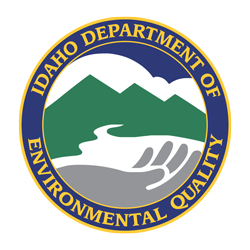September 3, 2021
VALLEY COUNTY — The Idaho Department of Environmental Quality (DEQ) is urging caution after national lab tests revealed the presence of cyanotoxins in material in the lakebed of North Beach.
DEQ sampled three sites after a dog fell ill after swimming in Payette Lake. The sites included the western edge of North Beach, a northwestern portion of the lake, and a section between Brown Park and Mile High Marina.
Preliminary results, which were shared with the public on August 27, 2021, indicated normal levels of cyanobacteria in the lake at all three locations. Final lab results, which DEQ received on September 2, 2021, did not reveal toxins in the water at any of the three sampled locations.
However, test results indicated that the North Beach benthic cyanobacteria—also known as bottom-dwelling cyanobacteria—contain low levels of cyanotoxins but may still cause illness if directly consumed. Cyanotoxins produced by benthic-cyanobacteria are not typically identified using standard lab tests.
The North Beach area is shallow and serves as the North Fork Payette River delta. The warmer-than-usual conditions can cause normal levels of cyanobacteria to grow and produce toxins.
Two of the toxins that were identified are relatively new to science and are not well understood. Since the toxins are thought to be contained within the cyanobacteria cells, not the water column, the levels are not high enough to issue a health advisory but the public should use caution when recreating in the North Beach area. Dogs that tend to ingest or chew on things are particularly at risk of toxin exposure. Please be aware of what your animals may come into contact with and do not let them eat things you didn’t provide. All lakes have a natural microbial community, including Giardia and Cryptosporidium, that may cause illness and all raw water should be filtered or purified before drinking.
Payette Lake continues to have high water quality and the benthic cyanobacteria DEQ’s investigation found are evidence of this. Since benthic cyanobacteria live and grow on the bottom, the water has to be clear enough to let light pass through to the bottom of the lake. This isn’t possible with the planktonic HABs (i.e., blooms in the water column) most people think of since surface blooms block light from reaching the substrate.
While other lakes experience planktonic HABs, the cyanobacteria found growing on the bottom of the North Beach are not widespread and they were difficult to find.
Sampling and testing for cyanobacteria and the toxins they can produce is a growing challenge for neighboring states and states across the country. Bloom conditions and toxin concentrations can change quickly, which can complicate monitoring efforts. As this investigation revealed, a lot of the science and lab techniques involved with cyanotoxin monitoring are new. As the scientific community’s understanding of cyanobacteria and the toxins they produce expands, new, advanced detection and identification methodologies will be identified and adopted.
DEQ always recommends people use caution when recreating in and around water, especially during the hot summer months. DEQ will continue to communicate proactively and transparently to ensure the public has access to timely health-related information.
To learn more about benthic cyanobacteria, please visit the California My Water Quality FAQs For Toxic Algal Mats at https://mywaterquality.ca.gov/habs/resources/benthic_education.html.
To learn more about drinking water from lakes and rivers, visit https://www.cdc.gov/healthywater/drinking/travel/index.html and https://www.cdc.gov/healthywater/web-features.html.
To learn more about current health advisories or report a suspected bloom, visit https://www.deq.idaho.gov/ water-quality/surface-water/cyanobacteria-harmful-algal-blooms/.

